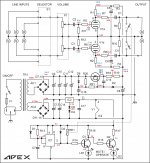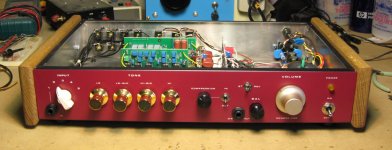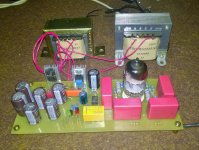Circuit as drawn shows 9V a.c.
What is your dc voltage across C14 when supplied with 6.3V a.c. When loaded, and unloaded. Maybe will need a low drop out regulator with this a.c. voltage?
What is your dc voltage across C14 when supplied with 6.3V a.c. When loaded, and unloaded. Maybe will need a low drop out regulator with this a.c. voltage?
Last edited:
Circuit as drawn shows 9V a.c.
What is your dc voltage across C14 when supplied with 6.3V a.c. When loaded, and unloaded. Maybe will need a low drop out regulator with this a.c. voltage?
8.66vdc unloaded 8.59vdc loaded.
Edit; Not unloaded but with the LEDs pulled. I didn't unsolder anything.
Last edited:
I am attaching a schematic with measured voltages. Voltages in red are with the tube installed. Voltages in blue are with it pulled.
I am using this transformer using the 100Vac secondary. It has two high voltage windings 100V and 120V. The data sheet only shows the 120V.
AS-05T120 - 50VA 120V Transformer - AnTek Products Corp
Let me know what you think.
I am using this transformer using the 100Vac secondary. It has two high voltage windings 100V and 120V. The data sheet only shows the 120V.
AS-05T120 - 50VA 120V Transformer - AnTek Products Corp
Let me know what you think.
Attachments
With a dropout voltage of an expected ~2.5V across the regulator, it's going to droop.
With that ac supply I would try a low dropout 5V regulator, and hope for a more reasonable ~1V to 1.5V dropout loss over the series component of the regulator.
Maybe
LM2940CT-5.0
LM1084 5.0V version (I've never used this regulator)
With that ac supply I would try a low dropout 5V regulator, and hope for a more reasonable ~1V to 1.5V dropout loss over the series component of the regulator.
Maybe
LM2940CT-5.0
LM1084 5.0V version (I've never used this regulator)
Last edited:
I may just try cutting the traces to the heater and running that directly from the 6.3vac.
I don't know much about tubes but is it supposed to run on 45v at the anodes? If so, why use such a high voltage transformer?
I don't know much about tubes but is it supposed to run on 45v at the anodes? If so, why use such a high voltage transformer?
I don't know much about tubes but is it supposed to run on 45v at the anodes? If so, why use such a high voltage transformer?
Voltage loss across the plate load resistor.
I haven't read the earlier parts of the thread- were the design problems in that schematic discussed?
Ok, I'm getting closer. I changed the regulator to an L7806. Now I have almost 6V at the heater which seems to be enough. It is working but the mute circuit takes almost 5 minutes to switch on. I don't quite understand how that circuit works. Can one of you explain it. It seems maybe it is too sensitive or not sensitive enough.
Thanks, Terry
Thanks, Terry
Update;
I looked up how the NE555 works and see that the trigger works by charging up C7. I watched and C7 was charging very slowly. So I reduced C7 first to 22uF and then 10uF. With 10uF there it takes about 30 seconds for the circuit to switch on. Next I paralleled and other 3M9 resistor onto R13 and that dropped the switch on time to about 15 seconds. That is acceptable. The preamp now works well with the ECC88 tube. I wanted to try the 6N1P. The first thing I noticed is the heater voltage drops more than a 1/2v. The L7806 heatsink temp rose to 65C which is not so good. Anode voltage on the tube went from 45v on the ECC88 to 90V on the 6N1P. The sound is good with both tubes. With the 6N1P tube, it take a full minute to reach 0V offset. I'm thinking that is because the heater voltage is not high enough. I am still considering cutting the traces to the heater nodes and running that direct from the transformer 6.3v secondaries. This transformer has two 6.3v windings so I have an extra to spare. That should reduce the heat on the L7806 as well.
It sounds really good. I ran square waves through it and they look beautiful. It does have a lot of gain. Should be good for low gain amps.
Blessings, Terry
I looked up how the NE555 works and see that the trigger works by charging up C7. I watched and C7 was charging very slowly. So I reduced C7 first to 22uF and then 10uF. With 10uF there it takes about 30 seconds for the circuit to switch on. Next I paralleled and other 3M9 resistor onto R13 and that dropped the switch on time to about 15 seconds. That is acceptable. The preamp now works well with the ECC88 tube. I wanted to try the 6N1P. The first thing I noticed is the heater voltage drops more than a 1/2v. The L7806 heatsink temp rose to 65C which is not so good. Anode voltage on the tube went from 45v on the ECC88 to 90V on the 6N1P. The sound is good with both tubes. With the 6N1P tube, it take a full minute to reach 0V offset. I'm thinking that is because the heater voltage is not high enough. I am still considering cutting the traces to the heater nodes and running that direct from the transformer 6.3v secondaries. This transformer has two 6.3v windings so I have an extra to spare. That should reduce the heat on the L7806 as well.
It sounds really good. I ran square waves through it and they look beautiful. It does have a lot of gain. Should be good for low gain amps.
Blessings, Terry
Hi Guys,
I cut the traces to the heater pins on the tube and added a jack so I could feed 6.3vac directly to the tube. Now the L7806 runs cool and the tube heats up more quickly. Further testing with the 6N1P shows that it doesn't settle to 0V offset. It stays at about 20mV. That is too much for a preamp so I can't recommend this tube. The ECC88 settles to +-1mv and stays there.
Blessings, Terry
I cut the traces to the heater pins on the tube and added a jack so I could feed 6.3vac directly to the tube. Now the L7806 runs cool and the tube heats up more quickly. Further testing with the 6N1P shows that it doesn't settle to 0V offset. It stays at about 20mV. That is too much for a preamp so I can't recommend this tube. The ECC88 settles to +-1mv and stays there.
Blessings, Terry
Attachments
Hi Guys,
I cut the traces to the heater pins on the tube and added a jack so I could feed 6.3vac directly to the tube. Now the L7806 runs cool and the tube heats up more quickly. Further testing with the 6N1P shows that it doesn't settle to 0V offset. It stays at about 20mV. That is too much for a preamp so I can't recommend this tube. The ECC88 settles to +-1mv and stays there.
Blessings, Terry
Nice work,
Regards
Nice work, this is something I really want to try.
I'll be etching pcb in the next two weeks
I recommend that you run the heater circuit separately and not with the regulator. Mine over heated with the heater but now the regulator is cool.
It sounds good but has a lot of gain so watch for that.
Blessings, Terry
I built an all opamp preamp (OPA2134's) that I'd put up against any preamp out there. It has a four section Baxandall tone control circuit (can't recommend it enough), and optional bi-amp outputs in addition to regular wideband outputs. The 4th order Linkwitz/Riley active crossover is set for 500HZ, for a speaker system I built to go with it. It also has active EQ that pumps up the low end by about 10dB at 32HZ (fast rolloff below that), so the acoustic output of my closed box 8 inch Focal kevlar woofer is close to flat down to 30HZ. If you really know how to use opamps right, and do grounding right, and you have a good tone control circuit, only then would a preamp compete well IMO.
Attachments
Hi Bob,
Where is the documentation for your opamp preamp. I would love to build it too. Have you built this circuit or one of Mile's other preamp circuits to compare yours to?
Blessings, Terry
Where is the documentation for your opamp preamp. I would love to build it too. Have you built this circuit or one of Mile's other preamp circuits to compare yours to?
Blessings, Terry
Terry,
Concerning APEX Counterpoint clone, I am not expert tor tubes but I think 15 seconds is not enough time to have cathode completely heated and working parameters stabilized. 30 seconds is more realistic.
If gain is too high you should use higher value log pot at the input, 100k or more.
Concerning APEX Counterpoint clone, I am not expert tor tubes but I think 15 seconds is not enough time to have cathode completely heated and working parameters stabilized. 30 seconds is more realistic.
If gain is too high you should use higher value log pot at the input, 100k or more.
Hi Ivan,
I'm sure you are right. I don't mind waiting as long as it settles to 0V. The 6N1P never gets there. The circuit is designed for the ECC88. No sense in trying to make it do something it won't.
As far as the gain goes, most of my amps are set up to use just a pot so this pre drives them pretty hard. A low gain amp would love this thing.
I'm sure you are right. I don't mind waiting as long as it settles to 0V. The 6N1P never gets there. The circuit is designed for the ECC88. No sense in trying to make it do something it won't.
As far as the gain goes, most of my amps are set up to use just a pot so this pre drives them pretty hard. A low gain amp would love this thing.
10dB attenuator cable
I suggest one essential accessory for gain reduction that can be used in many situations (too high output from source, etc): 10dB attenuator cable.
6k8 series resistor should be soldered inside sending end RCA plug and 3k3 parallel resistor should be soldered inside receiving end RCA plug.
Impedance of this att. cable is too low to be used at the output of this Counterpoint clone (it's optimized for solid state equipment) so it's better to use it at the input.
I suggest one essential accessory for gain reduction that can be used in many situations (too high output from source, etc): 10dB attenuator cable.
6k8 series resistor should be soldered inside sending end RCA plug and 3k3 parallel resistor should be soldered inside receiving end RCA plug.
Impedance of this att. cable is too low to be used at the output of this Counterpoint clone (it's optimized for solid state equipment) so it's better to use it at the input.
Last edited:
Very nice sound 🙂
Just 7806 getting hot but i still can touch heatsink
Nice work,
Regards
- Status
- Not open for further replies.
- Home
- Source & Line
- Analog Line Level
- Tube or SS Preamp?



